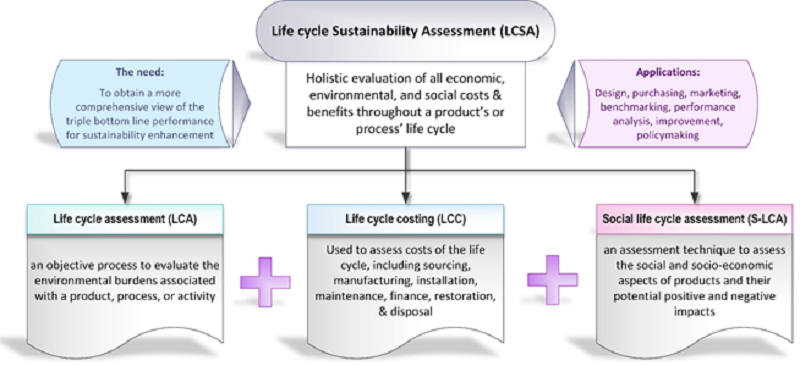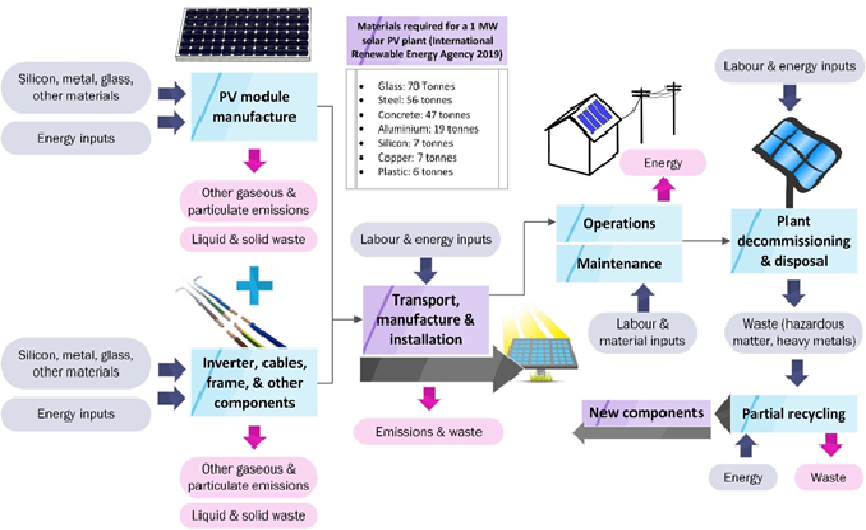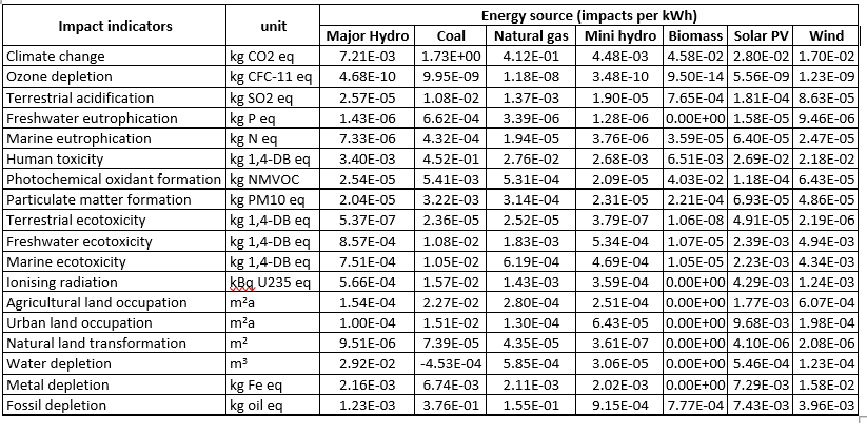Life cycle thinking for energy planning: The case of coal vs. solar
By Eng (Dr) Hirushie Karunathilake
Life cycle thinking is increasingly used all over the world for impact assessment, gaining traction over the past few decades. While this concept has gained an interest in Sri Lanka in the recent times, it has not yet seen widespread utilization in practical planning and decision-making applications. Energy systems and related decision making is one area that can greatly benefit from life cycle thinking-based decision making. In order to see the implications of using this method in planning energy systems, it is first helpful to take a look at what it entails.
Life cycle thinking
Life cycle thinking is connected to the life cycle sustainability assessment (LCSA), which is a standardised technique made up of the three components: life cycle assessment (LCA), life cycle costing (LCC), and social life cycle assessment (S-LCA), as depicted in Figure 1 [1]. These components correspond to the three dimensions or "pillars" of triple bottom line sustainability: environment, economy, and society. While the term "sustainability" is linked to environmental preservation in the minds of many, true sustainability cannot be achieved without paying attention to economic progress and societal wellbeing. The key difference between LSCA and other impact quantification approaches is that it takes a holistic perspective from the “cradle” (raw material extraction) to the “grave” (end of life) of a product, process, or a system [2].
 Figure 1: Life cycle sustainability assessment
Figure 1: Life cycle sustainability assessment
Various methods and tools have been developed over time to carry out LCA, LCC, and S-LCA. While LCA is in some cases conducted by itself to quantify environmental impacts, combining it with the other two pillars can provide a broader view of the impacts. LCA has been standardised internationally, with ISO 14040 and ISO 14044 being the leading standards documenting the general principles and specific requirements of carrying out an LCA. There are several other related standards focusing on carbon footprint and environmental labelling [3]. The four key steps of carrying out an LCA are (1) goal and scope definition, (2) inventory analysis, (3) impact assessment, and (4) interpretation. These phases can be extended and applied in LCSA as well.
During the goal and scope definition, the intended application, the reasons for carrying out the study, the target audience, and the intended use of the results are clearly defined. Further, the scope of the system to be studied is defined based on the functional unit of assessment (e.g., per kWh, per unit product, per tonne), the system boundary, the data requirements, and the allocation procedures among others. Depending on the intended goal of the assessment, different system boundaries can be defined, including cradle-to-grave (raw material extraction to disposal at end-of-life), gate-to-gate (between intermediate process phases), and cradle-to-gate (raw material extraction to intermediate process) [4]. The inputs and outputs of a system over its life cycle are compiled and interpreted during inventory analysis. Once the data is collected and processed during the inventory analysis phase, it is time for the life cycle impact assessment (LCIA), where the significant environmental (and other) impacts are evaluated under different categories. Interpretation is the phase during which the findings are aggregated, conclusions and recommendations are formulated, and reporting is carried out.
While LCSA can appraise all the favourable and adverse impacts pertaining to environmental, economic, and social aspects of a product, process, or a system, it is a data-intensive process. However, it is a highly useful assessment tool when it comes to decision making, particularly in dynamic and multi-faceted problems such as energy planning.
Energy planning: Goals, challenges, and decisions
“Ensuring access to affordable, reliable, sustainable, and modern energy for all” is the Goal 07 of the United Nations Sustainable Development Goals. Energy systems are thus a critical element of our civilisation today. Energy demand of a country or a region is supplied through various sources (including fossil fuels, renewable energy, and nuclear energy), and the systems themselves can be centralised or decentralised. When it comes to the planning of these energy systems, there are multiple stakeholders, goals and priorities, and constraints that come into play. Often, the expectations of different stakeholder groups conflict with each other. Today, it is universally accepted that while energy is a basic need for any society, energy systems need to be planned in a manner that is economically viable, environmentally responsible, and socially acceptable.
In reality, achieving this target is not so simple. The ever-increasing hunger of humanity for energy has accelerated climate change and other environmental damages across the world. The cheaper energy sources such as coal are often more environmentally damaging. However, clean energy sources such as wind and solar have reliability and dispatchability issues. While nuclear energy is on the face of it a clean and reliable source of power, social acceptance has been dubious due to the safety concerns. While renewables have long been touted as a panacea of all ills in the energy sector, the vast infrastructure investments required for their large-scale deployment can be unaffordable, especially for developing nations already suffering from energy poverty. To top it all, energy security, which is defined as “uninterrupted availability of energy at an affordable price”, is a distant dream for many parts of the world. All this makes clear that taking a triple bottom line sustainability perspective, covering economic, environmental, and social dimensions, is necessary in making the best energy choices as a country.
Energy sources and environment
The environmental impacts caused by fossil fuel combustion, particularly the emission of greenhouse gases (GHG) and the resultant climate change impacts, are the greatest argument against their use. In contrast, wind and solar energy technologies are claimed as “clean” energy sources with zero emissions. However, this statement is only partially true. While solar PV energy for example emits zero emissions during the operational phase where energy generation takes place, it has its own upstream and downstream impacts due to raw material extraction, manufacture and assembly, and the disposal of the waste at the end of the useful life. Thus, from a life cycle perspective, it is not truly zero emissions. End of life solar panels are in fact a source of hazardous e-waste, which has become quite a challenging problem in many parts of the world. As global solar industry soars, this is more and more likely to become a problem [5]. Figure 2 illustrates the life cycle stages as well as the inputs and outputs of each stage for a solar PV plant.
Not only solar, but essentially all energy generation technologies have upstream and downstream impacts due to component production, facility construction, and disposal in addition to the operations. Even in the operational stage, the much talked of GHG emissions are not the only problem. For example, thermal and nuclear power plants with once-through cooling systems that use a nearby water body as the cooling source cause “thermal pollution”, leading to great damage to aquatic ecosystems and native wildlife.
 Figure 2: Life cycle impacts of a solar PV plant
Figure 2: Life cycle impacts of a solar PV plant
Unlike traditional measures of environmental impact assessment that focus on a single life cycle phase (such as the generation phase) or a single damage category (such as climate change impacts), life cycle assessment provides a more comprehensive perspective, covering all stages and activities in the life cycle, all inflows and outflows, and multiple damage categories including GHG emissions, ecosystem damages, resource depletion, and health impacts. Table 1 summarises the average life cycle impacts of 1 kWh of electricity from different energy sources, quantified using ReCiPe Midpoint impact assessment method.
Table 1: Average life cycle impacts of 1 kWh of electricity from different energy sources

Economic dimensions of energy choices
Decision making for developing sustainable energy systems should therefore take life cycle impacts into account instead of merely focus on operational emissions. In addition, life cycle thinking is not merely about ecological preservation, but is a holistic framework to compare economic, environmental, and social costs and benefits. This multidimensional cost-benefit analysis is useful when it comes to the selection of the best energy sources and technologies for a region.
Sri Lanka does not possess its own indigenous fossil fuel reserves, and thus we have to rely on external supplies to cater our energy needs, putting the island at the mercy of global geopolitical forces and market dynamics. Sri Lanka, similar to many other developing nations, has come to rely on coal as a relatively affordable source of energy. However, shifting to renewable energy (RE) has long been a part of the nation’s long-term vision, and the latest targets aim for a 70% RE share in the electricity supply by 2030 while ceasing the construction of new coal power plants [6]. In addition to solar, wind, and biomass energy, LNG is also on the horizon for Sri Lanka’s energy sector.
The proponents of the RE transformation argue that in addition to delivering a cleaner energy supply for the country, the reduced reliance on imported fossil fuels will lead to long-term economic benefits and enhanced energy security. Another argument in favour of increased solar and wind integration is that it stops the draining of the country’s financial resources on energy imports. However, there are many counterarguments against this initiative, and some see it as “overly ambitious”. The requisite additional infrastructure development investment is also daunting, considering that the grid needs to be equipped to handle the supply fluctuations from RE, and most of the materials, components, and equipment necessary for RE facility development are also imported. One line of thought on this “solar vs. coal” decision is that both choices, ultimately, lead to supplies being imported from abroad, at a time of dwindling foreign exchange reserves.
The way forward
Where do we go from here? Does the choice to shift from fossil fuels to renewables deliver no economic benefits to the country ultimately? Where does Sri Lanka position itself in the battle for clean, secure, and affordable energy? These are the questions that need to be answered, and that is where holistic life cycle thinking encompassing economic, environmental, and social dimensions become a necessity in energy project evaluation.
Going back to the previous example of coal vs. solar, while the infrastructure development for both coal and solar power generation requires imported goods, the input material for continued plant operation (coal and sunlight) come from different origins. However, an extended assessment covering all the phases of energy infrastructure development, energy generation, plant maintenance, and end of life disposal as well as the indirect economic impacts of these projects (such as additional job creation, carbon credit trade, contribution to local economic development etc.) needs to be carried out before coming to a conclusion about which energy source is the better choice for the country. A simple cost assessment alone cannot cover the complexities associated with this problem, which requires a long-term economic outcome analysis based on life cycle economic and social impact assessments.
This analysis needs to be supplemented with a life cycle assessment that investigates all the long-term environmental impacts of solar and coal power, especially considering the resource extraction and waste generation during different life cycle stages. Ultimately, environmental damages and social problems caused by human activities and technological progress usually turn into problems that lead to economic costs in the long run. Therefore, even without the imperative of preserving our planet for future generations, economic interests alone make it worthwhile to investigate and consider the environmental dimension in energy-related decision making.
Life cycle is now being integrated to energy project evaluation, planning, and management across the world. Thus, it is high time for Sri Lanka to make use of this concept in our drive towards a sustainable and a secure energy future.
References
- A. Petrillo, F. De Felice, E. Jannelli, C. Autorino, M. Minutillo, and A. L. Lavadera, “Life cycle assessment (LCA) and life cycle cost (LCC) analysis model for a stand-alone hybrid renewable energy system,” Renew. Energy, vol. 95, pp. 337–355, Sep. 2016.
- M. Goedkoop, M. Oele, J. Leijting, T. Ponsioen, and E. Meijer, “Introduction to LCA with SimaPro,” San Francisco, 2016.
- G. Pallas, “Life cycle-based sustainability standards and guidelines,” PRé Sustainability, 2021. [Online]. Available: https://pre-sustainability.com/articles/lca-standards-and-guidelines/. [Accessed: 30-Oct-2021].
- T. T. Muthukumarana, H. P. Karunathilake, H. K. G. Punchihewa, M. M. I. D. Manthilake, and K. N. Hewage, “Life cycle environmental impacts of the apparel industry in Sri Lanka: Analysis of the energy sources,” J. Clean. Prod., vol. 172, pp. 1346–1357, 2018.
- J. Cross and D. Murray, “The afterlives of solar power: Waste and repair off the grid in Kenya,” Energy Res. Soc. Sci., vol. 44, pp. 100–109, Oct. 2018.
- U. Jayasinghe, “Sri Lanka to cease building coal-fired plants, aims to be net-zero emitter by 2050,” Reuters, 2021. [Online]. Available: https://www.reuters.com/business/sustainable-business/sri-lanka-cease-building-coal-fired-plants-aims-be-net-zero-emitter-by-2050-2021-09-24/. [Accessed: 30-Oct-2021].
 Eng (Dr) Hirushie Karunathilake holds a BSc in mechanical engineering and a PhD in Energy systems planning and decision making. She has worked on several research collaborations with the involvement of local governments of British Columbia and other industry partners in Canada. Currently she is attached to the Department of Mechanical Engineering, University of Moratuwa.
Eng (Dr) Hirushie Karunathilake holds a BSc in mechanical engineering and a PhD in Energy systems planning and decision making. She has worked on several research collaborations with the involvement of local governments of British Columbia and other industry partners in Canada. Currently she is attached to the Department of Mechanical Engineering, University of Moratuwa.





